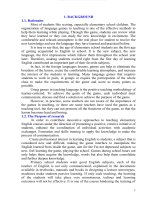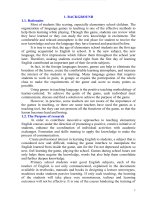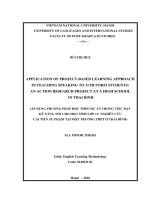Critical thinking: How to form ability of teaching critical thinking skills for high school teachers
Bạn đang xem bản rút gọn của tài liệu. Xem và tải ngay bản đầy đủ của tài liệu tại đây (499.29 KB, 6 trang )
TRƯỜNG ĐẠI HỌC SƯ PHẠM, ĐẠI HỌC HUẾ
CRITICAL THINKING: HOW TO FORM ABILITY OF TEACHING
CRITICAL THINKING SKILLS FOR HIGH SCHOOL TEACHERS
TRAN TRUNG HIEU
An Giang University
Email:
Abstract: Critical thinking skills, play an important role in developing problem
solving skills in learners, contributes to success in the workplace as well as in
higher education because it prepares students for a global society. The study
clarified its importance to learner’s success, and showed that almost high school
students do not have critical thinking skills and the majority of high school teachers
were not knowledgeable about critical thinking and how to teach it. In order to
develop this skill in the students, the paper has proposed that the teachers have to
be prepared the way to teach this skill such as (1) they have to be critical thinkers,
(2) they have to know how to develop an integrated lesson plan, and (3) they have
to master in cooperating teaching technologies.
Keywords: Critical thinking skills, integrated lesson plan, problem-solving
competence, critical thinkers, biology teaching.
1. INTRODUCTION
According to Phan (2008) [12], Nguyen (2015) [17], and Tran et al (2017) [9], most
high school students do not have critical thinking skills. How did this happen and why is it a
serious issue?
Facione (2011) pointed out that “critical thinking is thinking that has a purpose (proving
a point, interpreting what something means, solving a problem), but critical thinking can be a
collaborative, noncompetitive endeavor”. The learners can work together on a common
defense or a joint prosecution, and they can also cooperate with each other to get at the truth
so that justice is done. It involves six core critical thinking skills (Figure 1) [6].
Figure 1. Core critical thinking skills (Source: Facione, 2011)
Critical thinking skills play an important role in developing problem solving skills in
learners. Beyer (1995) said that “critical thinking is used in conjunction with other kinds of
thinking, such as solving problems, making decisions, conceptualizing, and creating
(synthesizing)” [2]. Critical thinking and problem solving are not separate; both of them are
incorporated in the thinking process (Pithers and Soden, 2000) [15]. Moreover, solving a
152
BÁO CÁO KHOA HỌC HỘI THẢO KHOA HỌC QUỐC GIA LẦN THỨ 1
problem is one phase in the overall critical thinking process (Hendricson, 2006) [7]. Problemsolving competence will be formed if the learners have critical thinking skills. In addition,
many researchers have explained that critical thinking contributes to success in the workplace
as well as in higher education, because it prepares students for a global society that have
become defined by high speed communications, complex and rapid change, and increasing
diversity (Shermis, 1992 [16]; Educator’s Voice, 2015 [4]). Although high school teachers
believed in critical thinking’s significance in improving learners’ thinking skills, most of them
were not knowledgeable about critical thinking and how to teach it (Phan, 2008 [12]; Nguyen,
2015 [17]; and Tran et al, 2017 [9]). Also from these studies, the majority of students knew
very little about the definition of critical thinking because they had not been taught this skill
in high school. This lack of critical thinking may lead to high school students not having
problem-solving competence to cope with work or university’s challenges after graduating.
Therefore, training high school teachers how to teach this skill is a vital and urgent solution.
2. HOW TO FORM ABILITY OF TEACHING CRITICAL THINKING SKILLS FOR
HIGH SCHOOL TEACHERS
2.1. Become critical thinkers
Good critical thinkers think critically about their own thinking. Therefore, they create an
argument, they think critically in order to be accurate and so that the argument is as strongly
reasoned as possible (Beyer, 1995 [2]). Ahuna (2014) announced that “a successful teacher
must have the higher order thinking skills necessary to appropriately adapt his/her instruction”
[1]. Therefore, becoming critical thinkers themselves will help high school teachers succeed
in teaching critical thinking skills in students. Grant (1988), associate professor and chair of
the Education Department at Occidental College in Los Angeles in California, claimed that in
order to develop critical thinking skills in students, teachers need a broad and deep knowledge
about the subject matter and pedagogical thinking because they are a means of shaping
decisions about what to teach and how to teach it [11].
In order to think critically, the teachers have to be trained through experts’ teacher
education programs in which these courses utilize Bloom’s taxonomy for categorizing kinds
of thinking (knowledge, comprehension, application, analysis, synthesis, evaluation) in two
ways. First, the course instructors ask higher level thinking questions of the students, such as
“What is the connection between students’ successful experiences and classroom
management?” and “Should low income schools receive more or less funding based on their
standardized test scores?” These kinds of questions encourage direct application of critical
thinking as students are confronted with real-life problems and how they can best be solved.
Second, students must utilize the taxonomy in crafting lesson objectives and plans. The goal
is for these future teachers to focus on moving their students to higher level thinking (Ahuna,
2014) [1].
When teachers master, they will own promising capabilities to assess the levels of
inherent broad categories of critical thinking skills in students. Based on this assessment,
teachers will have the stable foundation in designing lesson plan and organizing classroom in
the best way to teach this skill to students.
2.2. Integrate critical thinking skills into lesson plans
In addition to developing critical thinkers, building up an integrated lesson plan for
teaching critical thinking skills exposes key elements. According to Tran (1993) [10], Phan
(1999) [3] and Nguyen (2009) [8], the biology lesson is planned in some basic steps, such as
153
TRƯỜNG ĐẠI HỌC SƯ PHẠM, ĐẠI HỌC HUẾ
identify learning objectives, determine teaching aids, define educational methods, and
organize learning activities. Thus, in order to have an effective integrated lesson plan, the
study has proposed a process represented in Figure 2.
Figure 2. Schematic model of designing integrated lesson plan
154
BÁO CÁO KHOA HỌC HỘI THẢO KHOA HỌC QUỐC GIA LẦN THỨ 1
Step 1: Analyze contents of the lesson
- Identifying the goals of the lesson is important and indispensable because they are
requirements and aims which students have to achieve after finishing the lesson. In other
words, the goals are the measure of outcomes of the teaching process. Based on these goals,
the teacher can define necessary tasks such as how to control students’ explorating activities,
how to guide students to apply learnt knowledge and skills in solving exercises, and what
lessons students will gain. In addition, defining the goals has to base on education program’s
standards of knowledge, skills and competencies.
- Analyzing the structure of the lesson aims to identify relations between learnt
knowledge and skills and the knowledge and skills that students will be formed so that the
teacher can design learning activities effectively.
- The facts showed that mastering the lesson’s structure allows the teacher not only to
outline lesson’s units but also to be able to adjust the logic of these units. Moreover, this
master benefits the teacher from building up the systems of questions and exercises which
help students to apply harvested knowledge and skills in their learning activities
appropriately.
Step 2: Survey students’ characteristics and ability
In order to identify critical thinking skills with appropriate levels which need to be
trained, the teacher has to evaluate students on qualification, ability, and psychological
features. The results of this survey allow the teacher to collect and combine teaching
techniques and methods effectively in training process.
Step 3: Select and combine teaching techniques and methods
When selecting and combining teaching techniques and methods, the teacher has to pay
attention to: promoting students’ activeness, initiative and creativity; training self-learning
and cooperative learning skills; problem solving competence; and creating excitement in the
classroom.
Step 4: Refer to related biology materials
Finding and collecting related biology materials is one of the most important steps in the
process of designing integrated lesson plan. This collecting requires teacher’s considerable
time and effort. Then, the teacher will choose appropriate teaching equipments.
Step 5: Predict expected outcomes
The teacher needs to predict the knowledge, categories of critical thinking skills and
competencies which students can gain through the lesson. Unless these outcomes are as
expectations, previously identified critical thinking skills, the materials and teaching methods,
techniques and equipments have to be re-evaluated entirely to have more appropriate
selections and co-operations among them.
The teacher only begins writing the lesson plan when these outcomes have been
evaluated fully and entirely.
Step 6: Write the lesson plan
A lesson plan must ensure some requirements: (1) suit the standards of knowledge,
skills and competencies provided by the Vietnam Ministry of Education and Training
155
TRƯỜNG ĐẠI HỌC SƯ PHẠM, ĐẠI HỌC HUẾ
(MOET); (2) ensure to improve students’ critical thinking skills; (3) and organize various
teaching activities and promote students’ self-learning and creativity.
Step 7: Evaluate and adjust lesson plan after deploying the lesson
After finishing the lesson in the classroom, the teacher will review and evaluate the
success of the lesson to harvest experiences, find out shortcomings, and then adjust designed
lesson (if any).
This integration also allows teachers to clarify broad categories of critical thinking skills
with suitable levels that must be developed in students. It also allows teachers to assess the
competence of students, transform contents into thinking tasks, and select appropriate means
and the effective models of organizing the classroom. All these basic factors contribute to
success in developing this skill in the classroom. Moreover, incorporating critical thinking
into any transition program helps students avoid challenges of the academic setting with
critical thinking demands (Egege, 2004) [5].
Within a study for teaching critical thinking skills, Pinkney & Shaughnessy (2013)
wrote that educators can also integrate critical thinking into mainstream instruction at the
secondary and elementary levels [14].
2.3. Master basic teaching techniques
Organizing classroom into small groups through forms of representation such as the
game, battle and journey will develop this skill in students more effectively. In order to help
students to think critically, content is transformed into thinking assignments presented
through these models (Grant, 1998) [11]. In group works, these techniques help students to
better understand the material and stimulate their thinking process. In addition, the shared
responsibility reduced the anxiety associated with problem-solving. The facts have shown that
when students are learnt in small groups via these representation forms, they will develop
critical thinking through discussion, clarification of ideas and evaluation of others’ ideas. If
high school students are discussed in small groups through the game, the battle and the
journey, they will form this skill more effectively.
3. CONCLUSION
High school graduates will not adapt to the strict demands of living if they do not have
critical thinking skills. This generation is the main human resources for development of the
province in particular and the country in general. The study argues that students will think
critically only if their teachers are knowledgeable about critical thinking and how to integrate
this skill into the teaching process and organizing classroom techniques. The government
should invite experts or professors to train high school teachers how to teach critical thinking.
REFERENCES
[1]
[2]
[3]
[4]
Ahuna, K.H. (2014). A new era of critical thinking in professional programs.
Transformative Dialogues: Teaching & Learning Journal, 7(3), 1-9.
Beyer, K.B. (1995). Critical thinking. Phi Delta Kappa Educational Foundation
Bloomington, Indiana.
Phan Duc Duy. (1999). Trainning biology teaching skills for students based on studying
pedagogy cases. Doctor Thesis of Education, Hanoi National University of Education,
Vietnam.
Educator’s Voice. (2015). Critical thinking and Problem-solving for the 21st Century
learner. NYSUT’s Journal of Best Practice in Education, 3.
156
BÁO CÁO KHOA HỌC HỘI THẢO KHOA HỌC QUỐC GIA LẦN THỨ 1
[5]
[6]
[7]
[8]
[9]
[10]
[11]
[12]
[13]
[14]
[15]
[16]
[17]
Egege, S. (2004). Critical thinking: Integration in curriculum. International Education
Journal, 4(4), 75-85.
Facione, P.A. (2011). Critical thinking: What it is and why it counts. Measured Reasons
and the California Academic Press, Millbrae, CA.
Hendricson, W. D., Andrieu, S. C., Chadwick, D. G., Chmar, J. E., Cole, J. R., George,
M. C., Kalkwarf, K. L. (2006). Educational strategies associated with development of
problem-solving, critical thinking and self-directed learning. Journal of Dental
Education, 70(9), 925-936.
Nguyen Van Hien. (2009). Developing the skills of applying information technology in
organizing biology lessons in students. Doctor Thesis of Education, Hanoi National
University of Education, Vietnam.
Tran Trung Hieu & Khuu Thi Huynh Ngoc. (2017). Training critical thinking skills for
students in 10 grade and 11 grade biology teaching in some high schools in An Giang
province. An Giang University, Vietnam.
Tran Ba Hoanh. (1993). Techniques of biology teaching. Vietnam Education Publishing
House.
Grant, G. E. (1988). Teaching critical thinking. California: Praeger.
Phan Thi Luyen. (2008). Training high school students’ critical thinking based on
teaching the topic of equation and inequality. Doctor Thesis of Education, Hanoi
National University of Education, Vietnam.
National Education Association (n.d). Preparing 21st century students for a global
society: An Educator’s Guide to the “Four Cs”. Retrieved from
/>Pinkney, J., Shaughnessy, M.F., (2013). Teaching critical thinking skills: A modern
mandate. International Journal of Academic Research, 5(3), 346-352.
Pithers, R.T. & Soden, R. (2000). Critical thinking in education: A review. Educational
Research, 42(3), 237-249.
Shermis, S. S. (1992). Critical thinking: Helping students learning reflectively. Indiana:
ERIC Clearinghouse on Reading and Communication Skill.
Nguyen Phuong Thao. (2015). Developing critical thinking skills for high school students
based on dialogue acitivities in mathematics teaching in high schools. Doctor Thesis of
Education, Hanoi National University of Education, Vietnam.
157









